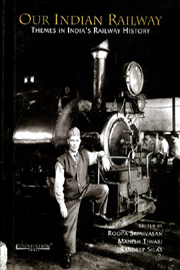Book contents
- Frontmatter
- Contents
- Foreword
- Preface
- Introduction
- 1 The Colonial Context of the Bengal Renaissance: A Note on Early Railway–Thinking in Bengal
- 2 Minute by Dalhousie on Introduction of Railways in India, as Submitted to the Court of Directors, 4 July 1850
- 3 Ackworth Committee Report
- 4 Competition and Adaptation: The Operation of Railways in Northern India: Uttar Pradesh 1860–1914
- 5 Economic Nationalism and the Railway Debate, circa 1880-1905
- 6 Railway Policing and Security in Colonial India, c. 1860–1930
- 7 Indian Nationalism and Railways
- 8 The Railway in Colonial India: Between Ideas and Impacts
- 9 The Dark Side of the Force: Mistakes, Mismanagement and the Malfeasance in Early Railways of the British Indian Empire
- 10 Tunnels and Bridges: Railways, Narrative and Power in two Novels of India
- 11 A View of the History of Indian Railways
- 12 The Romance of Steam
- Index
- Plate section
5 - Economic Nationalism and the Railway Debate, circa 1880-1905
Published online by Cambridge University Press: 26 October 2011
- Frontmatter
- Contents
- Foreword
- Preface
- Introduction
- 1 The Colonial Context of the Bengal Renaissance: A Note on Early Railway–Thinking in Bengal
- 2 Minute by Dalhousie on Introduction of Railways in India, as Submitted to the Court of Directors, 4 July 1850
- 3 Ackworth Committee Report
- 4 Competition and Adaptation: The Operation of Railways in Northern India: Uttar Pradesh 1860–1914
- 5 Economic Nationalism and the Railway Debate, circa 1880-1905
- 6 Railway Policing and Security in Colonial India, c. 1860–1930
- 7 Indian Nationalism and Railways
- 8 The Railway in Colonial India: Between Ideas and Impacts
- 9 The Dark Side of the Force: Mistakes, Mismanagement and the Malfeasance in Early Railways of the British Indian Empire
- 10 Tunnels and Bridges: Railways, Narrative and Power in two Novels of India
- 11 A View of the History of Indian Railways
- 12 The Romance of Steam
- Index
- Plate section
Summary
The development of the country by the construction of railways … is the method by which we can materially improve the condition of the vast population dependent upon agriculture most surely and most steadily.
—Lord ElginThe Indian people feel that this construction is undertaken principally in the interests of English commercial and moneyed classes, and that it assists in the further exploitation of our resources.
—G.K. GokhaleThe construction of railways had a revolutionary impact on the life, culture, and economy of the Indian people. Not till their establishment could the British truly penetrate Indian life, link India with the growing world market, and set it on the path of capitalist development. As a matter of fact, railways began, in course of time, to be looked upon by the alien rulers of the country as a panacea for all its economic ills, and their development was pressed on with vigour and vehemence, getting priority over everything else.
The history of the construction of the Indian railways is, no doubt, ‘an oft-told tale’ nevertheless, we take the liberty of giving here a brief resume in order to better appreciate the approach of the early Indian national leadership towards the various issues emanating from railway construction in the country.
A Brief Historical Sketch
The earliest proposal to build a railway in India seems to have been made in Madras in 1831–1832. But this railway was to depend for its haulage-power on animals. Steam railways for India were for the first time projected in 1843, this time in England.
- Type
- Chapter
- Information
- Our Indian RailwayThemes in India's Railway History, pp. 77 - 120Publisher: Foundation BooksPrint publication year: 2006
- 19
- Cited by

